
RAID: World War II Review
If you were to adapt Tarantino’s Inglourious Basterds into a co-operative first-person shooter, you’d get something along the lines of RAID: World War II. It’s 1941 and the onslaught of Hitler’s forces are advancing fast on England. In their most desperate hour, British Secret Intelligence conscribe four criminals with a history of robbing banks and stealing trains and promise them with great riches in return for dismantling the führer’s regime from behind enemy lines.
Set in and around wartime Berlin, RAID: World War II allows up to four players to take on different missions against the Nazis. Whether it involves blowing up tanks or intercepting a convoy, if it bears the swastika, it’s a target. Recruited by Control (played by veteran comic actor John Cleese) and handled by the enigmatic Mrs. White (Rosemary Alldred), these four men are thrown into the hornet’s nest.
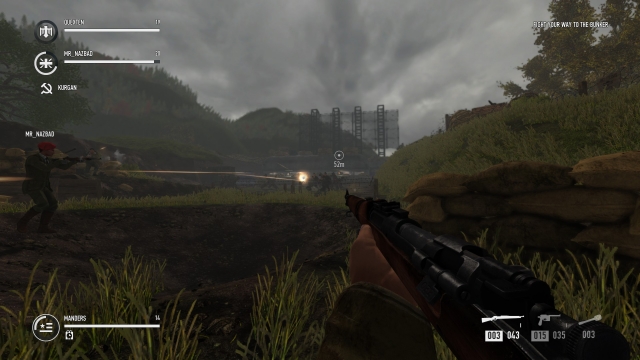
Creative Director Ilija Petrusic intended RAID: World War II to be a spiritual sequel to Overkill’s Payday series, which he had also worked on several years previously. It includes many of the same mechanics and trademarks; as you carry out missions (called ‘raids’ in-game) you’ll have to shift bags, assassinate Nazi generals and rescue prisoners, all while under fire from the Wehrmacht and SS troops. During these missions you’ll also find yourself faced against special enemies with unique weaponry, such as snipers that will fire from afar, spotters that use flares to signal artillery fire, officers that toughen up nearby soldiers, and the flamethrower unit, a deadly combatant that you won’t want to face alone.
One of the first raids I took had me infiltrating a fortress known as the Schloss Blomberg – a location that gave off many Return to Castle Wolfenstein vibes – to assassinate two captured Russian generals amidst fears that they have confessed information regarding the upcoming Allied summer offensive. I began by using dynamite to blow through the front gates, charged the halls of the Blomberg and completed my task with utmost efficiency. Afterwards, I had to use the fortress’ radio tower to contact Mrs. White for an escape plan.
The layout of the castle was the main thing that impressed me. There was a clear sense of progression as I advanced, and the floor plan was complex enough that I never felt like I had to backtrack. In its visuals, the level was also incredibly appealing. The exteriors looked distinctly German, with half-timbered rooftops and Gothic brick design. It wasn’t confusing at all and ultimately stood out as one of my immediate favourite levels of the game.
A quick five minutes of playing brought my attention to one of the game’s most apparent flaws; the enemy AI. Rather than using cover, thinking tactically or adapting to the situation, soldiers will just pile up in a hallway and rush at you without learning that same strategy didn’t bode well for their former comrades who tried the same thing a few moments ago. There was even a time where a flamethrower enemy proceeded to blast his entire team full of fire while I hid safely in cover. It just seemed very disappointing to have such clever map design only to have a less than stellar AI system.
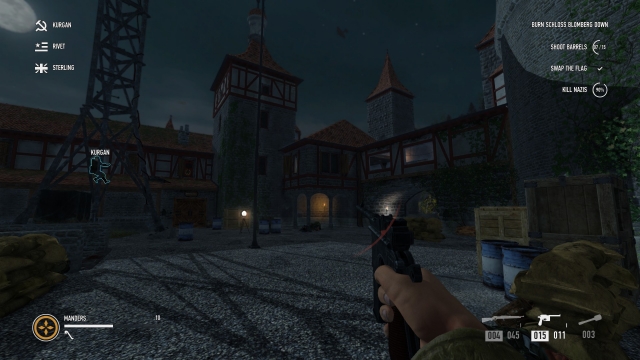
Another aspect from Payday: the Heist that Petrusic wanted to bring back was its use of interaction through dialogue. During a raid, characters call out to each other and discuss how to proceed. Many missions require improvisation on their part, and this will be apparent through their communication with each other. Not only that but the dialogue itself feels very period-accurate. Characters will use idioms and phrases no longer used today, and even the way the radio voices sound, especially that of the Sabre Squadron fighter pilot, sounds like actual authentic recordings from the Second World War.
Alongside the single-level raids that Control gives you, there are also missions known as ‘outlaw raids’, which are all about getting rich. Instead of sabotaging Nazi settlements, this time you’re robbing them for as much gold as you can carry. There are only two such raids available at the moment – one involving hitting a convoy and another where the gang rob a gallery – but it is expected that Lion Game Lion will release more in the coming months. In case these missions still aren’t enough for you, there is also the option to play longer campaigns called ‘operations’. Here, you will be navigating Berlin in a string of different missions similar to Left 4 Dead’s campaigns. Overall, these operations can take up to an hour to complete and are incredibly difficult. They require a different kind of teamwork as opposed to the standard raids.
For the most part, the skill system – known as ‘proficiences’ – is expansive but lacklustre. While there is much room for diversity when making a particular build, most proficiencies are passive and don’t feel that satisfying to unlock. Add this on top of the incredible grind of the later levels, and it soon becomes a massive drag to spend three hours for “10% more health”, even if it will ultimately help you. This same system applies to upgrading weapons, which are unlocked as you level up. Using that gun more will give you upgrades to make it stronger and more efficient as well as giving you bonuses such as increased magazine size or better optics to aim with.
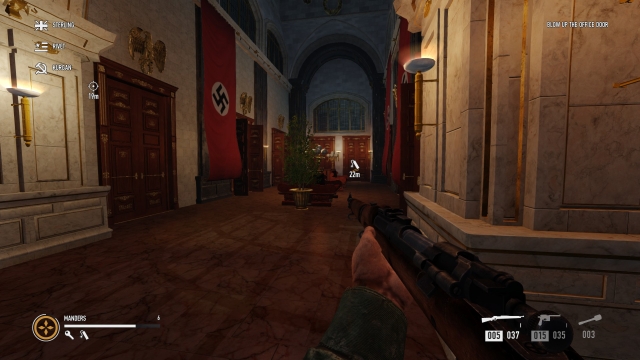
RAID: World War II also runs on the famously un-optimised Diesel engine, which was one of Payday 2’s biggest problems. Framerates are jittery and multiplayer sometimes becomes desynchronised to the point where I don’t even know where exactly my teammates are on the map. It was a bad idea to use this engine for the game, as it also means the graphics suffer a lot. Lion Game Lion chose to use this engine as the developers are more familiar with it than anything else, so it’s understandable why RAID uses it. It doesn’t completely break the game, but there will be moments of player frustration as a result.
The game also makes use of an RNG (Random Number Generator) system to determine how certain mission objectives or map layouts are calculated. This was another big feature of the Payday series but can also be seen in games such as Left 4 Dead and XCOM. With this, how every raid plays out will differ on each game, allowing for there to never be an identical playthrough. In many ways, this can turn off players due to how your success may depend on good RNG, however I feel that this system is much less punishing than past examples.
I played a few rounds of a mission called Wiretap with three other players. Here, we were tasked with rescuing a scientist from a small fort and then protecting him while he used a device to record several Nazi transmissions. As the scientist began his work, a tiger tank approached our barricades to the south. Being too low-ranked to deal with this tank, we decided to stay back at the fort and hold off the enemy forces from there. As predicted, the tank made its way to us very quickly and blew the gates open. Nazi forces swarmed in and attacked us from all angles. We were wiped out almost immediately.
We restarted, this time holding our ground closer to the front barricade. We even found some dynamite to blow up a bridge the tank would later try and cross. Now that we knew what we were up against, our defense was stronger. We didn’t get boxed in as much, instead being able to focus on protecting the barricade. The tank did prove to be a problem, however, and we were eventually overwhelmed to the point we were forced to retreat. History repeated itself, and soon enough the tank had blown open the gates to the fort once again. This time, we took more defensive positions inside, and waited for the enemies to come to us. Of course, this resulted in the scientist getting killed off pretty quickly, forcing us to perform the recording ourselves. Again, this proved a difficult task and we ended up getting killed again.
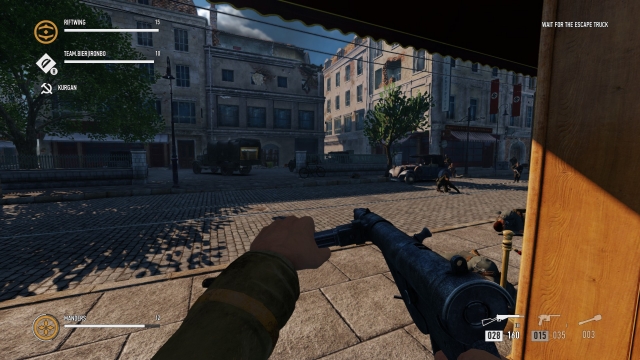
For our final go at this mission, we elected to take different strategic roles in holding back the Nazis. I took up a vantage point on the fort’s walls overlooking our barricade, whereas another player was watching out for enemies with dynamite that sought to destroy it. The final two players operated the heavy machine guns, taking in the heat of the battle and holding back the enemy waves. We were largely successful in this endeavour, managing to keep the tank away from the scientist and allowing him to complete his work and survive. In the end, this mission proved that RAID: World War II’s mission structure is both fluid and adaptive to RNG as well as player interaction. When we performed badly, we received worse results. When we played better – as a team – the mission went much more smoothly. I’ve found playing co-operative raids to be much more satisfying when every player fills a role and can synergise well with their teammates.
RAID: World War II (Reviewed on Windows)
Game is enjoyable, outweighing the issues there may be.
On a whole, RAID: World War II feels exactly like what you’d expect from a Payday clone. It takes less of a political approach than other games featuring Nazis such as Wolfenstein or the upcoming Call of Duty: WW2, and instead moves away from the ‘war is hell’ narrative to opt for a more hyper-violent, stylised approach to the subject matter. While the choice of game engine severely lets itself down, there is still much to appreciate if you enjoy other co-operative shooters of its type.


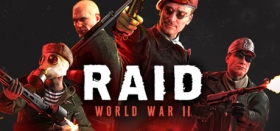







COMMENTS
Erin - 08:46pm, 16th October 2017
A potato flew around my room